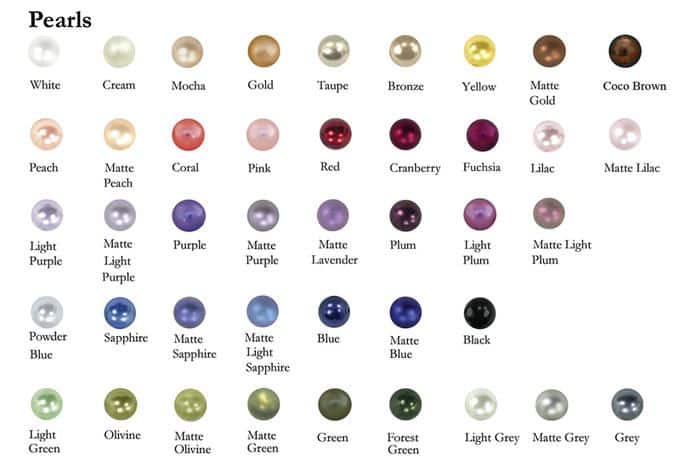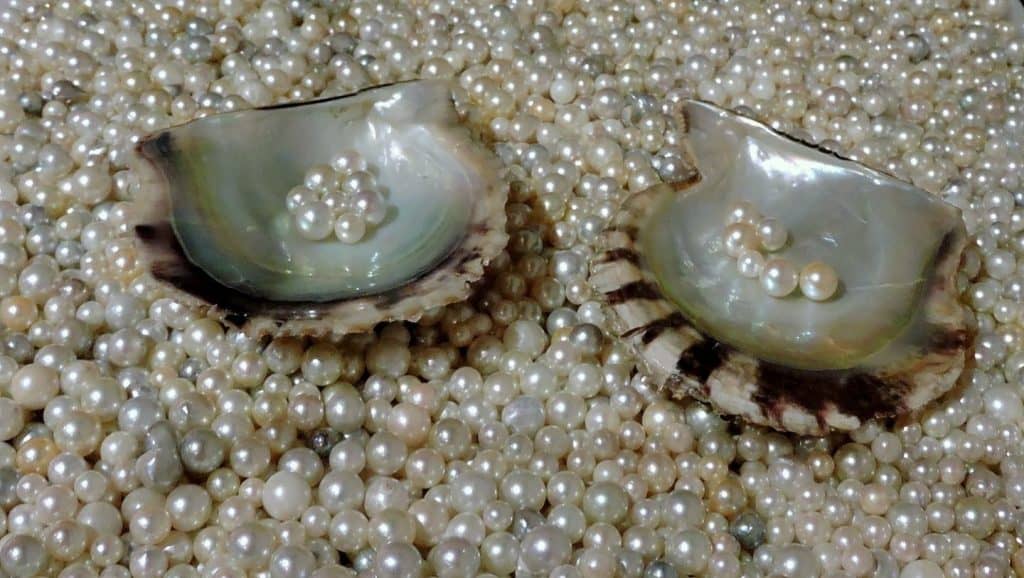Mother of Pearl VS Pearl- A Detailed Discussion Below
It’s true that both pearl and mother of pearl are precious gemstones and have a lot of value, especially in the jewelry sector.
But are they the same thing? Is pearl made of mother of pearl?
Not really. Despite being made from the same substance, nacre, they are two quite different things.
The mother of pearl is formed in the inner layer of some mollusk shells whereas a pearl is found deep inside the mollusks. Basically, when a foreign object like sand enters the shell, the mollusk embays that object with a concentric layer of nacre. Thus a round-shaped pearl is created being enclosed within a mollusk shell.
However, there are some other distinctions as well. So, let’s walk you through the key differences between Mother of Pearl VS Pearl below.
What Is Pearl?

A pearl is one of the most precious gemstones in the world which is sourced from a living organism. It’s a hard, shiny, and spherical object that developed deep inside an oyster or mollusk shell.
Being composed of calcium carbonate, they are generally creamy white in color. When a foreign body enters a mollusk shell, it might cause infection or irritation. To prevent that irritation, the mollusk encases the foreign substance layer after layer of nacre which later results in a pearl.
A pearl could be produced both in saltwater and freshwater. Although saltwater pearls are more popular for their perfectly round shapes and therefore, they are more expensive as well.
Nevertheless, the freshwater pearls could be of different shapes such as peanut, potato, baroque, button, etc.
Besides, they are of different grades based on quality.
Types of Pearl

Most interestingly, there are two types of pearls. One is natural which is formed naturally.
Usually, a foreign object slips into a mollusk shell and the mollusk then coats that irritant with several layers of nacre. That’s how natural pearls are created within the mollusk tissue.
On the other hand, there are cultured pearls where the irritant is artificially inserted within pearl oysters or mollusks. The rest of the process is the same though.
However, it takes almost three years to create cultured pearls if you want to ensure high quality.
On the contrary, there are low-quality cultured pearls that are taken out of the shell without giving sufficient time.
Resultantly, they are formed with a thin nacre coating which makes them less valuable.
As natural pearls are very rare, cultured pearls are produced more in recent years to cope with the demand for this highly precious gemstone.
What Is Mother of Pearl?

Before explaining what the mother of pearl is, we want to know what you think of it. Do you think the mother of pearl holds the upper hand here because of the term- mother?
Not really. A mother of pearl is the iridescent, strong, and resilient inner layer within a mollusk shell that is created to protect the mollusk from a foreign substance.
This is also known as nacre and is mostly formed inside mollusks like pearl oysters or abalones.
As they are formed in the inner linings of a mollusk shell, they are present in every mollusk out there. So, they are more common compared to pearls.
A mother of pearl has a flat surface and it’s mainly created against a foreign object such as a piece of sand to save the shellfish from irritation and abrasion.
So, it’s basically a pearly inner layer inside the mollusk shell that gives birth to a pearl by being built against an irritant.
Features of Mother of Pearl
Having an exclusive multi-color effect, a mother of pearl gleams in different colors. You can get them in different colors such as white, bronze, silver, pink, yellow, green, etc.
Besides, they could be artificially tinted to your favorite colors.
As it has no distinct shape, the mother of pearl has the shape of the shell where it is produced.
Resultantly, it has the ability to cover larger areas such as watch faces, door knobs, photo frames, etc.
Besides, they are used for different decorative purposes too as you can carve them into exclusive shapes and designs.
Surprisingly, its believed that the mother of pearl consists of stress-relieving properties and therefore, they are widely worn by women.
Key Differences Between Mother of Pearl vs Pearl
Here comes the key difference between pearl and mother of pearl. Let’s have an in-depth analysis below to specify these two distinct gems.
Source
Very interestingly, these two gemstones are sourced from the same material which is called nacre. As nacre is secreted by a mollusk as a shield against a foreign particle or parasite, it encases that particle with layers to protect the soft tissues of the mollusk.
So, they both are composed of calcium carbonate which is the basic material of nacre, and therefore, they both are organic gemstones.
But the main distinction lies in the placement of these two. Pearl is formed deep inside the tissue of an oyster or mollusk.
On the other hand, a mother of pearl is the thin layer inside the mollusk shell that coats a foreign particle only to give birth to a pearl.
Shape
A natural pearl is usually round/spherical in shape. Although cultured pearls could be of different shapes and sizes.
On the other hand, the mother of pearl takes the shape of the shell it lines.
Availability
Undoubtedly, both pearl and mother of pearl are highly valuable gems.
Despite being formed of the same material, they are not equally available. Every mollusk that secretes nacre has a mother of pearl inside.
But that doesn’t mean you will get a pearl inside each mollusk.
As the composition of a pearl is a tangling and lengthy process, naturally formed pearls are quite rare.
Price
If we take the availability of these two gems into consideration, pearls are rarer and resultantly, they are more expensive and demandable.
Jewelry
As already mentioned, the mother of pearl is less expensive and more common. So, they are more budget-friendly for making jewelry.
Being iridescent glittering, mother-of-pearl jewelry shines brighter in some stunning colors.
As they could be engraved into larger designs, you can get gorgeous bracelets, watch faces, buttons, and many more from the mother of pearl.
However, pearl jewelry has a timeless appeal and it’s often synonymous with the aristocracy.
Saying that pearls are smaller in size and they are often made into beads to be embodied in a ring, pendant, earrings, etc.
History
Both pearl and the mother of pearl have a long and enriched history.
But compared to the mother of pearls, the history of pearls is glorified more due to its admiration even by celebrities and royal members.
Mother of Pearl vs Pearl: Comparison Chart
| Mother of Pearl | Pearl |
| An iridescent inner layer within the mollusk shell | A hard and shiny substance encased by the mother of pearl deep inside the mollusk tissue |
| Exists almost in every mollusk | Very rare |
| Doesn’t have its own shape | Usually spherical in shape |
| Could be of different colors due to its iridescent effect | Usually comes in creamy white color |
| Less expensive | More expensive |
Similar blogs: Mother of Pearl VS Abalone (Here)
FAQs
Is the mother of pearl worth anything?
Of course, they are. Being more affordable, they can be engraved into gorgeous pieces of jewelry. Besides, they are also used for architectural purposes, making decorative items, etc.
Is the mother of pearl better than pearl?
Not exactly. In fact, pearls are more valuable as they are rarely available. Moreover, it takes a pretty long time for natural pearls to be formed.
How do you tell if a pearl is real or fake?
Being 100% hypoallergenic, real pearls will never let you experience an allergic reaction. Also, you can test the authenticity of the pearl in a simple way. Tap it against your teeth and it should make a sound like ‘click’.
How long do pearls last?
If you can take good care, they can last for a long time. With proper care and maintenance, they can look newish even after 50 years.
What are fake pearls called?
Usually, fake pearls are called faux, imitation, or costume. And fake pearls are made of plastic, glass, fish-scale imitation, etc.
Final Words
To conclude this comparison between Mother of Pearl VS Pearl, we must say that both these organic gemstones highly contribute to the jewelry industry. They are one of the greatest miracles of mother nature.
However, the key difference lies in their process of formation and placement.
The pearly inner layer within a mollusk shell is called the mother of pearl/nacre whereas a pearl is generated only when the mollusk throws that nacre against a parasite/particle.
And as the chance of entering a foreign particle inside the mollusk shell is relatively low, natural pearls are way rarer than the mother of pearl.
Resultantly, pearls are more expensive and have been shaped into mind-blowing pieces of jewelry for years.
